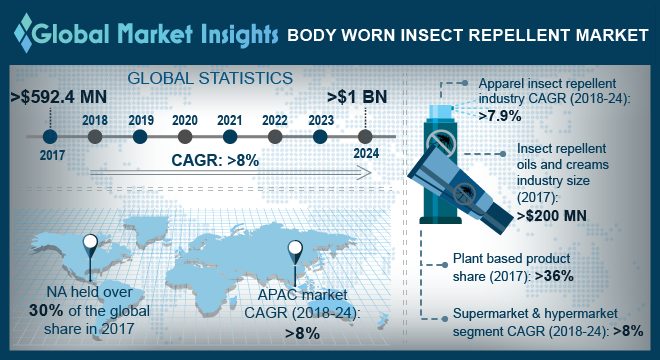Home > Consumer Goods & Services > Personal Care > Skin Care > Body Worn Insect Repellent Market
Body Worn Insect Repellent Market Size
- Report ID: GMI1807
- Published Date: May 2018
- Report Format: PDF
Body Worn Insect Repellent Market Size
Body Worn Insect Repellent Market size was worth over USD 592.4 million in 2017 and will witness over 8% CAGR up to 2024.

Increasing preference to attain prevention from bug borne diseases such as Zika, Malaria, Chikungunya, and dengue impacting body worn insect repellent demand. Surge in mosquitos’ protection products purchase especially for underage kids, grown children and pregnant women are contributing a major market share.
In 2016, WHO estimated over 445,000 deaths by malaria globally on comparing over 446,000 deaths in 2015. Moreover, 91% of total malaria deaths were recorded in Africa followed by South East Asia which accounted more than 6%. Malaysia, Thailand, Vietnam and Indonesia are major countries witnessing vector borne disease outbreak.
According to Center for Disease Control (CDC) U.S., 47 out of 50 states registered mosquito borne disease including West Nile Virus (WNV), Eastern equine encephalitis (EEE) and Zika. California recorded more than 509 cases and 28 deaths, Texas registered 133 cases and 5 deaths, Arizona noted over 109 cases and 8 deaths by WNV in 2017.
| Report Attribute | Details |
|---|---|
| Base Year: | 2017 |
| Body Worn Insect Repellent Market Size in 2017: | 592.4 Million (USD) |
| Forecast Period: | 2018 to 2024 |
| Forecast Period 2018 to 2024 CAGR: | 8% |
| 2024 Value Projection: | 1 Billion (USD) |
| Historical Data for: | 2013 to 2017 |
| No. of Pages: | 388 |
| Tables, Charts & Figures: | 614 |
| Segments covered: | Product, Distribution Channel and Region |
| Growth Drivers: |
|
| Pitfalls & Challenges: |
|
Brazil registered several types of vector-borne diseases, including Zika virus, Dengue, and Chikungunya in the 2015-2016 period. Over one million and a half population were directly affected by these deadly viruses. Government agencies have taken qualitative measure to protect from these diseases by promoting the usage of insect repelling products including sprays, creams, lotions, liquid, nets, and apparel are strong supporting body worn insect repellent demand.
The U.S. government and Environment Protection Agency are positively promoting benefits of DEET as most effective insects and mosquito’s repellent agent presently. DEET is naturally found composition available in liquid, lotions, sprays and impregnates range such as roll on & Towelettes. Registered formulations are safe for direct application on human skin that contains 5% to 99% DEET compositions. It is safe for children, adults, pregnant women and old age adults due to no age limit for usage are driving body worn insect repellent market share.
Increasing R&D regarding mosquito repelling formulation has led towards the usage of DEET and Lemon Eucalyptus in across various bug repellents products. Nowadays sprays have become a most suitable items of choices among consumer due to the easiest method to apply on skin and clothing. Companies are focused on increasing production along with extending the product range owing to the rising adoption of these products escalating body worn insect repellent market share.
In certain cases, unhealthy instances noticed among patients such as breathing problem, skin itching & rashes, unpleasant odour by cream formulation, which may negatively impact demand. Aerosol sprays can cause breathing problems due to chemical droplets comes out of pressurized containers causes uneasiness in kid and women may hamper demand.
